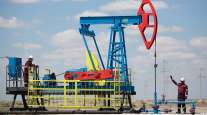Associated Press
OPEC+ Boosts Oil Output by Slower Pace Than Previous Months

[Stay on top of transportation news: Get TTNews in your inbox.]
The OPEC oil cartel and its allies decided Aug. 3 to boost production in September by a much slower pace than in previous months at a time of high gasoline prices and unstable energy supplies exacerbated by Russia’s war in Ukraine.
OPEC, led by Saudi Arabia, and its allies, led by Russia, said they will increase output to 100,000 barrels a day next month after raising it by 648,000 barrels per day in July and August. The group considered what effects staggering inflation and rising COVID-19 rates may have on global demand for fuel in the fall.
It comes after U.S. President Joe Biden visited Saudi Arabia last month, aiming to improve relations and encourage more oil production from the cartel to draw down high prices at the pump. While gasoline prices have been falling, they are still high and posing a political problem for him as inflation surges.
DIESEL DROPS FOR SIXTH STRAIGHT WEEK: Aug. 1 price at $5.138 a gallon
No oil production agreement was announced, but Biden said he expected OPEC to take steps to increase production in the coming weeks. Those hopes didn’t materialize.
The White House responded by stressing that what matters is the steady decline in oil and gasoline prices from summer highs. White House press secretary Karine Jean-Pierre noted that the decline began June 14, the day the administration disclosed plans for Biden's trip to Israel and Saudi Arabia.
“The fact of the matter is that oil and gas prices are coming down,” Jean-Pierre told reporters at Aug. 3's White House briefing. “The moment he announced his trip we saw gas prices and oil prices coming down.”
But with the OPEC+ announcement, “the U.S. may go looking for other sources of oil, whether it’s Venezuela or Iran,” said Jacques Rousseau, managing director at Clearview Energy Partners.
Biden’s administration also is encouraging the U.S. oil and gas industry to increase production.
“You’ve just seen the second-quarter results from some of these companies. They are record profits,” Amos Hochstein, a senior adviser for energy security at the State Department, said Aug. 3 on CNBC. “They should be investing those dollars right back into production increases.”
Despite the modest increase announced by OPEC+, the administration was trying to highlight that prices are already falling and could fall further with more domestic production.
“We’re pretty pleased with what we’re seeing” on prices for oil and gas down from highs, but “we know that this is not enough,” Hochstein said.
A senior Biden administration official, who insisted on anonymity to discuss private conversations, called the OPEC+ announcement a step forward. The official said the group has restored all the production cuts it made in 2020 during the depths of the pandemic, when oil prices and demand plummeted.
The group has been gradually adding more oil and gas to the market as economies recovered.
Some OPEC nations, such as Angola and Nigeria, have been producing less than the agreed-upon amount. Saudi Arabia and United Arab Emirates, on the other hand, have the capacity to increase production.
OPEC’s decision appears to be an attempt to appease those countries that can’t produce more, Rousseau said.
“Any time you increase the target, there’s countries that can’t participate,” he added. “If you only raise production by 100,000 barrels per day, that’s just a small piece for everybody.”
As a result, the amount of oil on the market might not keep up with demand, so high oil prices may persist for some time.
While the U.S. was probably hoping for a larger production increase, “in terms of overall supply/demand management, OPEC’s decision is logical,” Noah Barrett, research analyst for energy and utilities at Janus Henderson Investors, said in a note. “There’s still a great deal of uncertainty on oil demand in the back half of this year, driven by questions around Chinese demand, and the potential for U.S. or even a global recession.”
Want more news? Listen to today's daily briefing above or go here for more info
The price of oil rose sharply after Russia invaded Ukraine in February. It fell somewhat since OPEC+ last met but rose modestly Aug. 3. A barrel of U.S. benchmark crude was selling for just over $94, compared with more than $105 per barrel a month ago. Brent crude, the international standard, was selling for just over $100 a barrel, also down about $110 from a month ago.
In the U.S., a gallon of regular gasoline was selling for $4.16 on average Aug. 3. That’s substantially lower than in June, when the nationwide average surpassed $5 a gallon, but it’s still painfully high for many front-line workers and families to afford and about 31% higher than what drivers were paying a year ago.
Associated Press writers Josh Boak and Zeke Miller in Washington contributed to this report.




